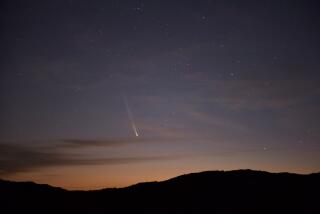Universal Appeal
- Share via
Already waning, but still putting on quite a show, the mountain-size comet known as Hale-Bopp continues to be visible in the northwestern sky through the middle of May.
By mid-April, the waxing moon will begin to drown out the far reaches of the comet’s 40-million-mile-long tail, but observers in Los Angeles and elsewhere still will be able to see the comet itself, said Griffith Observatory program director John Mosely.
The glittering lights of the city produce the equivalent of “a full moon every night,” he said. “When you’re in L.A., you don’t see the ends of the tail anyway.”
To view the comet, look in the northwestern sky about an hour after sunset for a fuzzy ball of light. A pair of binoculars should bring out at least a section of the white fan-like dust tail--so filmy and tenuous that if you took a piece of comet tail as big as the Pacific Ocean and condensed it, it could be packed into a suitcase, said Griffith Observatory Director Ed Krupp. The comet’s second tail--a thin blue strip of electrically charged particles--is more difficult to see.
Like all comets, Hale-Bopp is a chip off the ancient cloud of stardust that formed our solar system, and carries clues to the origins of Earth and everything on it, including people. Preserved in frozen storage in the outer reaches of the solar system, the 25-mile-diameter collection of ice and rock heats up as it approaches the sun. Increasing pressure forms cracks in its tough carbon crust, allowing gas and dust to steam out in unpredictable eruptions. The fast-blowing solar wind blows the comet-stuff into a streaming tail.
Once Hale-Bopp disappears into the glare of the sun in mid-May, it won’t be back for some 2,400 years. However, its tail will leave behind a permanent legacy in the form of meteors, or “shooting stars.”
“When you’re looking at the tail, you’re looking at millions of future meteors,” Mosley said. “We’re not going to see the comet again, but those little pieces of dust that form the tail are going to be around for a while.”
More to Read
Sign up for The Wild
We’ll help you find the best places to hike, bike and run, as well as the perfect silent spots for meditation and yoga.
You may occasionally receive promotional content from the Los Angeles Times.






